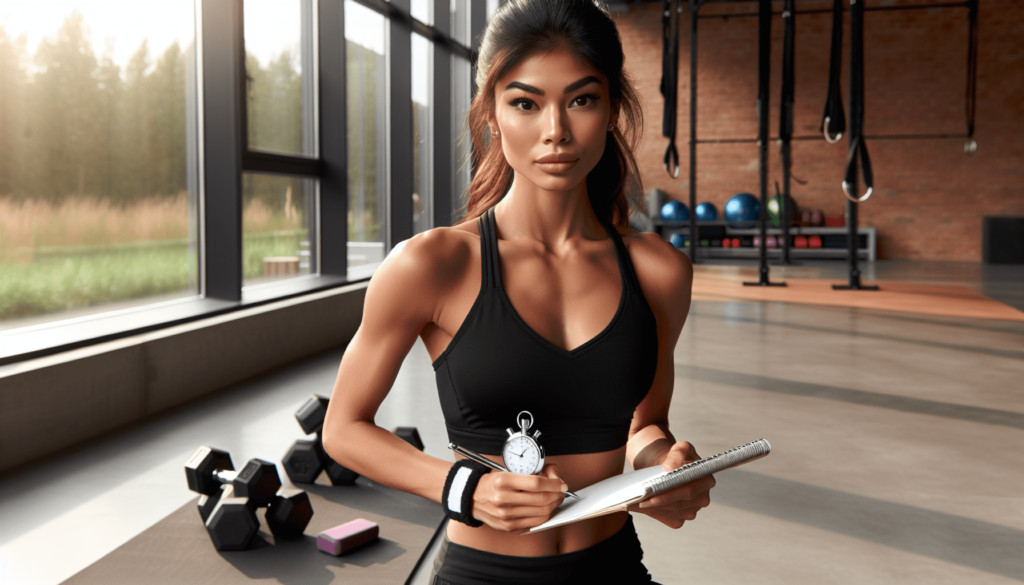How many times have you stared in horror at your own reflection, wondering which one of you ate the slim person in the picture from five years ago?
Or perhaps you’ve gingerly walked into a gym and wondered why everyone looks like they were designed by a comic book artist? Fitness can be a mystifying world when you’re just starting out, like a clumsy baby giraffe trying to leave the safety of the less embarrassing savanna.
To kick things off, you don’t need to be confused as to how to measure those gains that everyone keeps jabbering about. The journey might seem like trying to climb Mount Everest using only a cheese grater, but fear not! We’re here to guide you through the wild safari of gauging fitness improvements without fear, frustration, or frequent faceplants.

Why Measure Your Fitness Gains?
Understanding the “why” behind measuring your fitness progress is almost as crucial as resisting the urge to devour a double cheeseburger at each successful mile run. Measuring progress is like noting a toddler’s transformation from potato stage to functional mini-human—it’s important to track!
Your Motivation Monster
First and foremost, measuring progress is like feeding a giant, fuzzy monster named Motivation. Each new achievement is like a delicious snack that keeps the monster satisfied and you pressing forward. If you notice your running time improving or your biceps resembling something other than spaghetti noodles, you’re more likely to keep going, and less likely to try and reason with the treadmill to stay stationary.
The Proof is in the Pudding (But Don’t Eat the Pudding)
Measuring progress provides evidence that can silence your inner saboteur. It’s more than just hoping your jeans have a generous stretch to them—it’s having factual proof of your progress. That way, when someone says, “Wow, you’ve lost weight,” you can reassure them that it’s true and not just a clever trick of the light or weight-lifting-induced hallucination.
Methods of Measuring Fitness Gains
Trying to measure your gains in the world of fitness is akin to deciphering hieroglyphics or trying to assemble Swedish furniture without a manual. Let’s streamline those efforts with some practical methods.
The Mirror: A Reflection of Reality and a Comedy Show
Mirrors are the simplest tool in your arsenal. They never lie, which can be both enlightening and terrifying. Using a mirror to assess your visual and tonal progress is straightforward: you simply look. However, in doing so, resist absurd body antics to magically enhance the view. Be consistent: try to examine yourself at the same time under the same conditions. Friday night with low lighting and soft music may not be optimal for accurate assessments.
Weight Loss/Gain: Because Either Can be Your Victory Dance
This method involves weighing yourself, though your scale likely didn’t graduate from an Ivy League school in accuracy. Weigh-in once or twice a week at the same time and under the same conditions to maintain consistency. Whether you’re trying to lose or gain weight, fluctuations are as unpredictable as a cat deciding whether to nap or to scratch your furniture. Focus on long-term trends rather than daily variations.
Tape Measure: Not Just for Crafting Costumes
The tape measure is a bit like physical examination for clothes—you’ve got those specific points where circumference actually matters. Take measurements of your chest, waist, hips, arms, and legs, and jot them down. This practice might make you feel like a primed piece of carpentry, but you’ll be glad when you see change in the form of lost inches (or gained, in the case of wanting biceps like Thor).
Performance Indicators: The Rocky Balboa Method
This is where you focus on actual physical abilities—like running faster than a three-legged tortoise or lifting heavier than your average bag of groceries. Keep track of how long you can jog, how heavy you lift, how many times you can lift a donut to your lips without taking a bite (well, preferably less on this measure).
Photos: Capturing Your Evolution, Minus the Dinosaurs
Take progress photos in regular intervals—think of it as creating a flip book of your physical evolution that doesn’t involve animating drastic transformation over short periods. Wear minimal, form-fitting clothing to make both the positive and less wanted changes apparent. Choose a regular backdrop and lighting for consistency; a monthly or bi-monthly schedule will ensure you don’t start flooding your memory card with too much evidence of your awesomeness.

Embrace the Journey: Fitness is More Like a Soap Opera, Less Like a Highlight Reel
Be Patient: Rome Wasn’t Built in a Day, and Neither Is Your Six-Pack
When embarking on any fitness journey, be it conquering a new sport or simply avoiding injury while attempting various forms of coordinated physical movement, it’s essential to remember that patience is crucial. Sure, there’s motivation, inspiration, and perspiration, but let’s not forget exasperation. Results often take time. Like cultivating a bonsai tree or figuring out the plot of Inception, it requires perseverance.
Celebrate Small Wins: Dance Like Nobody’s Watching (or Judging)
Whether it’s dropping a pound, shedding a body fat percentage point, running a minute faster, or bubbling over with endorphins from a jovial Zumba class, celebrate your milestones. No milestone is too small. It’s like songwriting; we don’t all need to write a Grammy-winning song. Sometimes, your rewards might include a frozen yogurt (or an extra episode of something that doesn’t involve fitness influencers). Acknowledge every achievement, and pat yourself on the back—in moderation, as too much patting can result in sore arms.
Stay Accountable: An Exercise Buddy to Match your Wakanda Warrior Spirit
Finding a fitness buddy can make the experience more enjoyable rather than enduring a solo symphony. This doesn’t mean dragging Bill from Accounting if he shares no similar interests. Take on someone who matches or challenges your enthusiasm—a human cheerleader of sorts. If you can, financially invest in a trainer who can provide both encouragement and (occasionally) a yellow card warning against lazy form.
Adapt and Overcome: The Plot Twists of Your Fitness Journey
The longest running soap opera may boast decades of drama, change, and (un)surprising character resurrections, and your fitness-jeopard is similar. Sometimes, something doesn’t work—perhaps your arms refuse to cooperate for push-ups or quinoa is your mortal enemy. The key is to adapt. Find new exercises, revisit the ones not as (un)enjoyable, or Google epic smoothie recipes until fruits and vegetables excite more than cheese-grating gratins.
Avoiding the Pitfalls: The Never-Ending Gym Class Drama
Don’t Compare Yourself to Instagram Models: #NoThanks
One potential red flag of frustration is the dreaded “Instagram vs. Reality” phenomenon. Social media is a girdle of cleverly disguised effortlessness—highlight reels of fitness professionals and digital avatars who appear to have hours of photo-editing expertise. “Comparison” is like trying to water a cactus during a drought; it will only end with your mood in the desert of despair. Appreciate their posts, but remember—take the content with a grain of healthy skepticism.
Fitness Slumps are Real: Eject Before You Flop
Ah, the pesky slump—a page from the diary of a struggling (but not forgotten) soap opera character. Fitness slumps are real and the worst games to play alone. Once your progress feels stagnant, stop and assess your approach. Are you overwhelmed by the treadmill’s mocking beep, or is the rowing machine questioning your life choices by glancing back at you? Take a break, revise, or inject a fun exercise to stave off the epic tragedy of losing your workout groove.
Equipment-induced Anxiety: The Dumbbell Dilemma
If you’ve ever wandered past rows of gym equipment wondering how everything instantly transforms into a medieval torture device upon inspection, you’re not alone. But don’t allow this conundrum to scare you back into non-exercise territory. Seek out benevolent souls (maybe that trainer) to guide you through the proper use of equipment—the results might surprise you, and you’ll gain confidence as well as muscle strength.
Keeping Consistency: Channel Your Inner Gym Novelist
Set Realistic Goals: Don’t Aim for the Moon and Miss
In setting fitness goals, avoid sculpting plans that even Michelangelo would consider over-ambitious. Like attempting four marathons with no training, we often scale mountain-sized expectations. Small, actionable goals move the needle from being entirely stationary—sort of like a thief stealthily lifting one spoon from a locked vault over weeks. Focus on short-term goals, and success shall deliver a proper crescendo toward larger orientations.
Routine: The Steady Companion of Pros
Routine is like a golden retriever: steadfast, reliable, and occasionally drooling (though your fitness sweat is less adorable). Establish a weekly or monthly exercise schedule to make exercise an everyday companion rather than an unattainable hobby. Block off specific times each week to dedicate your routine’s dance—your gym shoes will thank you, and the consistent effort shall yield dividends.
Mix It Up: Choreograph a Unique Fitness Dance
If life is a dance, then visualize your workouts as the persistent beat. Incorporating various forms of exercise can prevent boredom, if not dismay. Balance cardio, strength training, and the artful sway in between. Noone’s playlist contains a single song—it’s the variety that keeps our feet tapping, and our journeys as enjoyable as they are successful.
Track Progress and Adjust: Engage in Fitness Analytics (with Fewer Spreadsheets)
Imagine measuring progress as interpreting a rather compelling yet chaotic novel (with fewer improbable romantic subplots). Track metrics, revel in tangible data, and adjust accordingly to ensure your goals are more Shakespeare than Shakespearean tragedy. Maintaining records oftentimes helps in bringing giggles over how far you’ve wandered since your fitness debut. Keeping mental checklists, fitness apps, or even a journal will prevent deviations toward the opera du flop.
An exciting, slightly hilarious, yet genuinely informed fitness journey can indeed sidestep the overwhelming wooziness brought on by Instagram spirituality. Changes will occur, motivation shall ebb and flow, and before you know it, the reflection won’t seem like a stranger from another universe, but rather, just another version of you.
Surprise yourself and conquer the world, one squat at a time!
